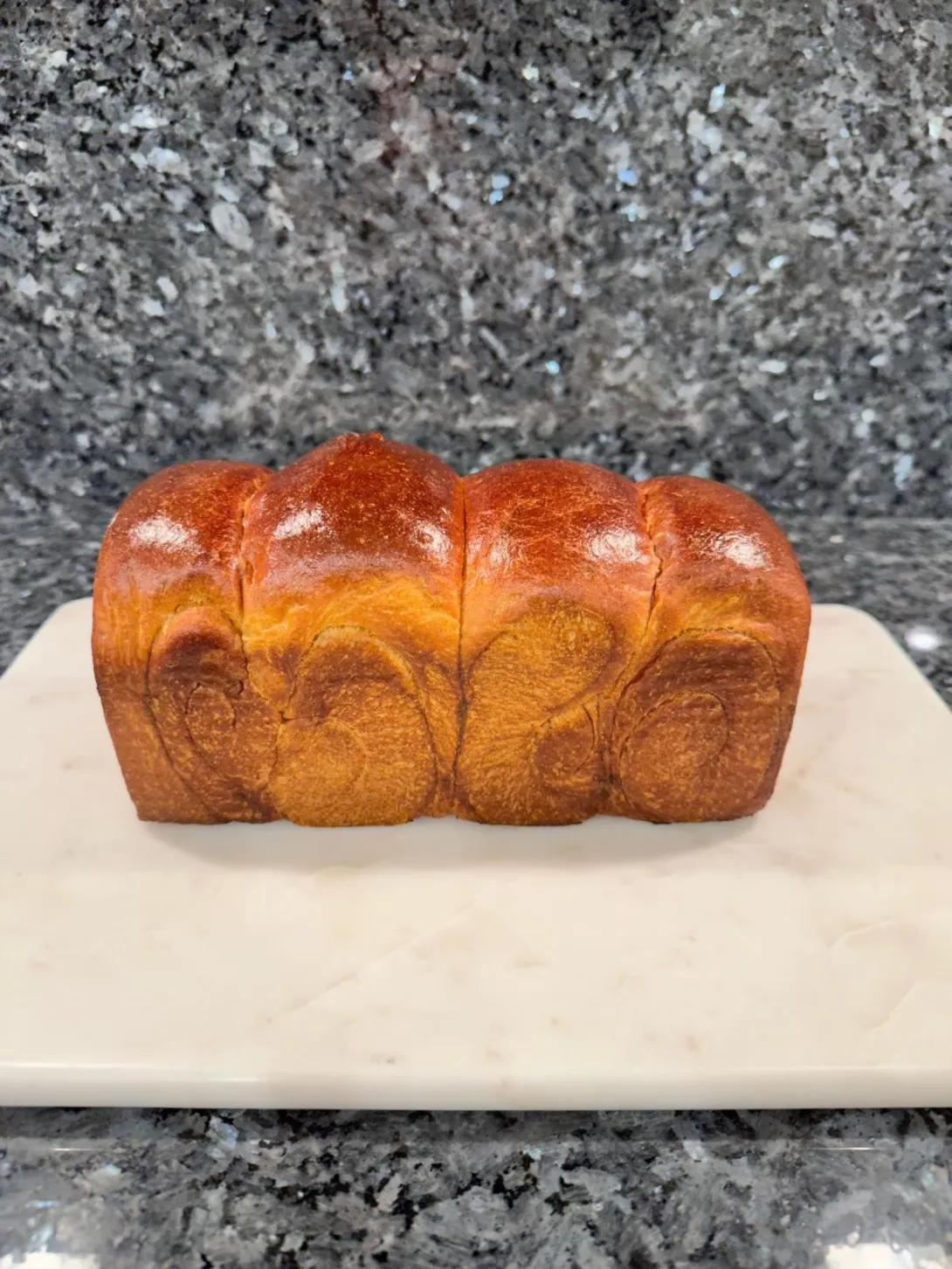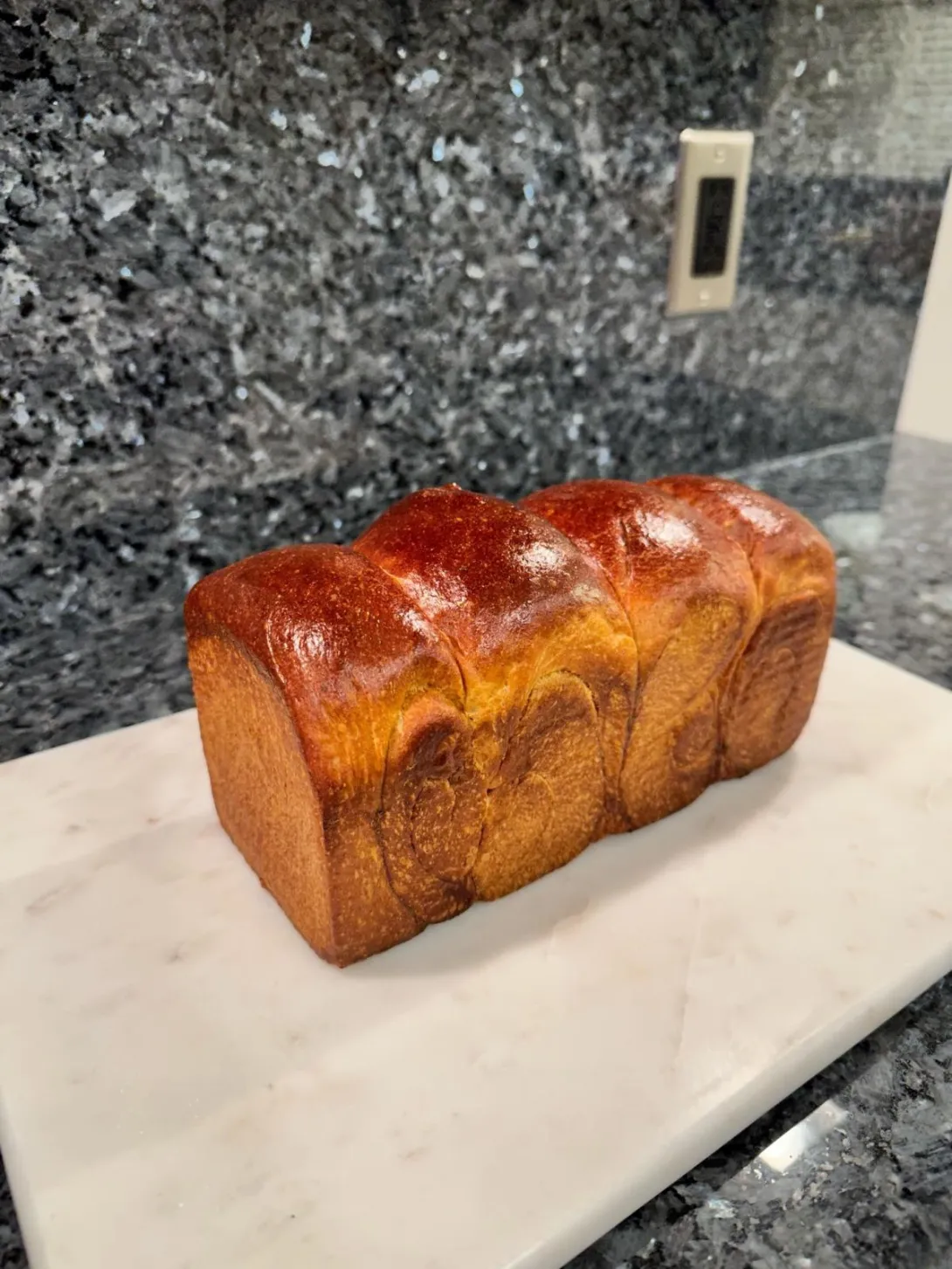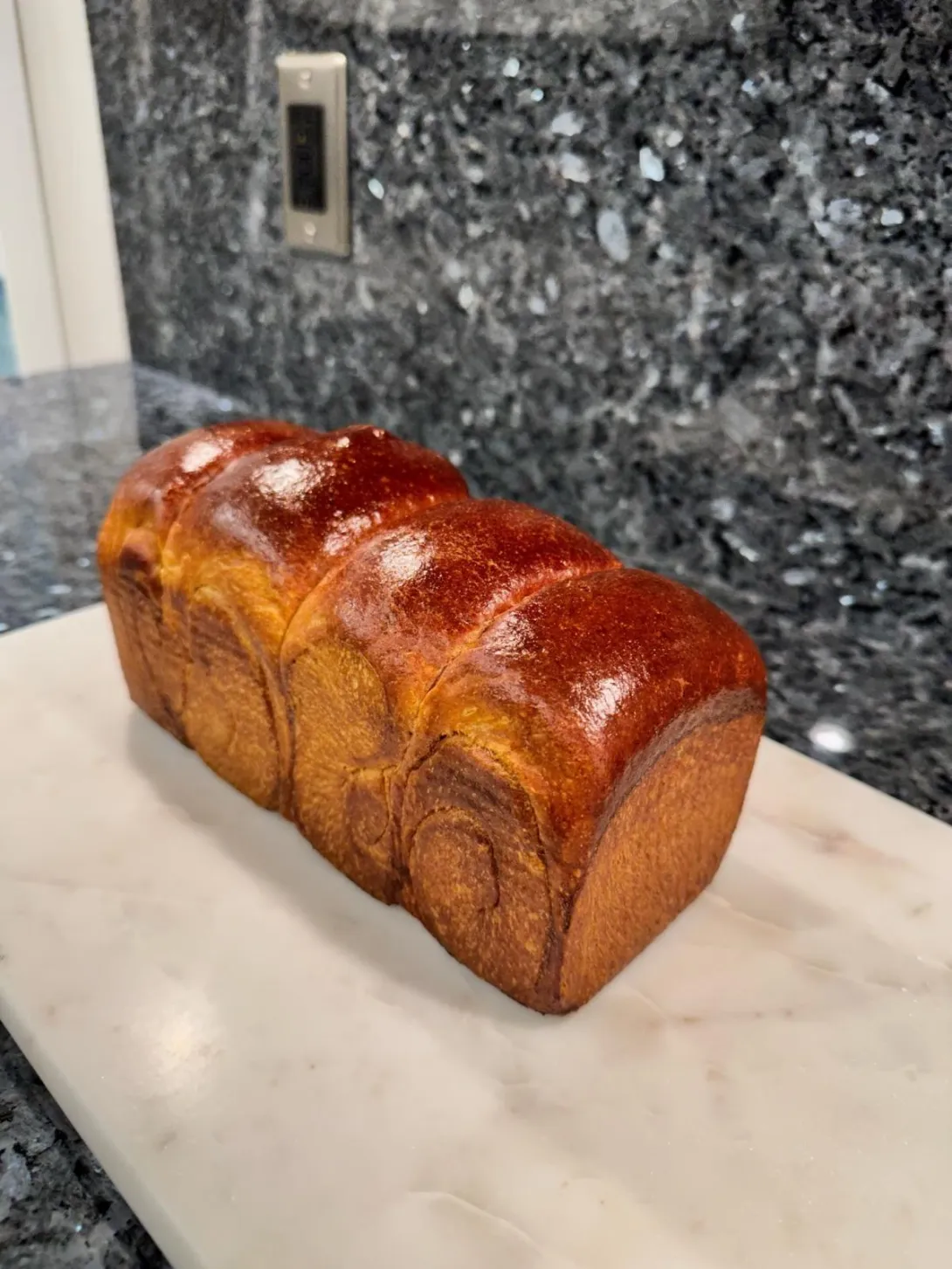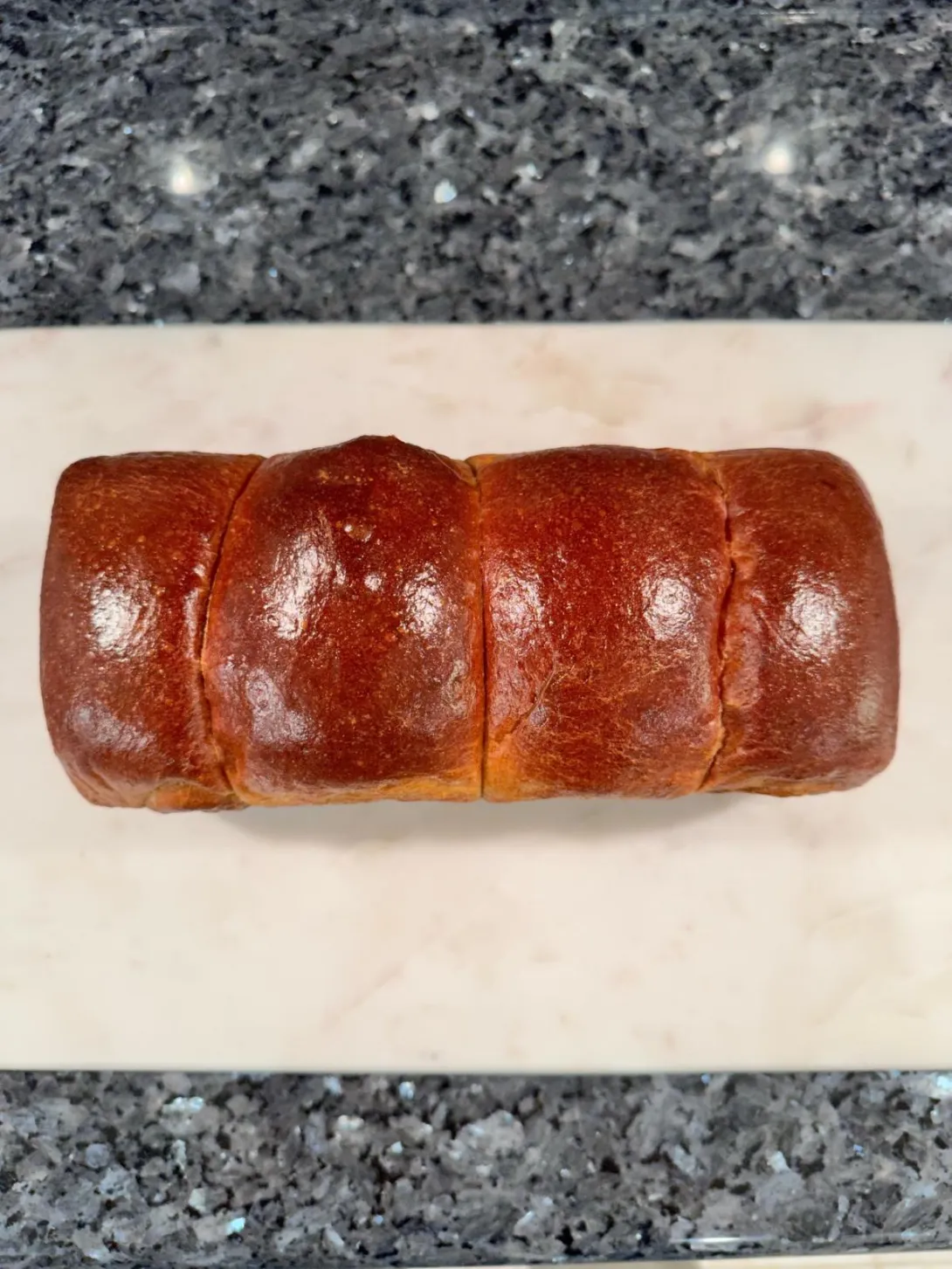We’re back down in Fort Lauderdale for 2.5 months and Alan was kind enough to share some of his starter with me, thank you Alan. He also gave me some SAF gold and red IDY along with some whole rye. Immediately I note how different his starter smells than mine. Mine is fed 100% whole rye and has a much more sour smell. This starter is fed KA AP I believe and is much less sour and a bit sweet smelling.
We had no bread so I thought I’d bake using Alan’s starter and to also gradually adjust my Hokkaido milk bread formula. I’ve decided to use a 1:2 ratio of flour to milk for the tangzhong, this allows me to increase the percentage of flour in the tangzhong from 7 to 15%, the greatest I’ve tried so far. From what I’ve recently read this should allow a great flavour improvement and texture improvement from the tangzhong. If I was still using the 1:5 ratio at 15%, there wouldn’t be any liquid left for the dough mix since most if not all of the liquid for the dough would be in the tangzhong.
Despite the instructions below, I fully hand mixed and developed the dough.


For one 9x4x4” Pullman pan loaf.
Instructions
Levain
Mix the levain ingredients in a jar or pyrex container with space for at least 300% growth.
Press down with your knuckles or silicone spatula to create a uniform surface and to push out air.
At a temperature of 76-78ºF, it typically takes up to 10-12 hours for this sweet stiff levain to be at peak. For my starter I typically see 3-3.5 times increase in size at peak. The levain will smell sweet with only a mild tang.
Tangzhong
In a sauce pan set on medium heat, stir the milk and whole wheat flour until blended. Then cook for several minutes until well thickened, stirring regularly with a spoon or heat-resistant spatula. Let cool in the pan or, for faster results, in a new bowl. Theoretically it should reach 65ºC (149ºF) but I don’t find I need to measure the temperature as the tangzhong gelatinizes at this temperature. You can prepare this the night before and refrigerate it, ensure that it is covered to prevent it from drying out.
If you plan on using a stand mixer to mix this dough, set up a Bain Marie and use your stand mixer’s bowl to prepare the tangzhong.
Dough
In the bowl of a stand mixer, add the milk (consider holding back 10 g of milk and adding later if this is the first time you’re making this), egg, tangzhong, salt, sugar and levain. Mix and then break up the levain into many smaller pieces. Next add the flours. I like to use my spatula to mix until there aren’t many dry areas. Allow the flour to hydrate (fermentolyse) for 20-30 minutes. Mix on low speed and then medium speed until moderate gluten development this may take 5-10 mins. You may want to scrape the sides of the bowl during the first 5 minutes of mixing. Next add room temperature butter one pat at a time. The dough may come apart, be patient, continue to mix until it comes together before adding in more butter. Once all the butter has been added and incorporated increase the speed gradually to medium. Mix at medium speed until the gluten is well developed, approximately 10 mins. You will want to check gluten development by windowpane during this time and stop mixing when you get a good windowpane. You should be able to pull a good windowpane, not quite as good as a white flour because the bran will interrupt the windowpane somewhat.
On the counter, shape the dough into a tight ball, cover in the bowl and ferment for 2 - 3 hours at 82ºF. There should be some rise visible at this stage.
You can next place the dough into the fridge to chill the dough for about 1.5 hours, this makes rolling the dough easier to shape. Remember, if you do so the final proof will take longer. Alternatively, you can do a cold retard in the fridge overnight, however, you may find that this increases the tang in your bread.
Prepare your pans by greasing them with butter or line with parchment paper.
Lightly flour the top of the dough. Scrape the dough out onto a clean counter top and divide it into four. I like to weigh them to have equal sized lobes. Shape each tightly into a boule, allow to rest 5 mins. Using a rolling pin roll each ball out and then letterfold. Turn 90* and using a rolling pin roll each out to at least 8”. Letterfold again from the sides so you have a long narrow dough. Then using a rolling pin, roll flatter but keeping the dough relatively narrow. The reason to do this extra letterfold is that the shorter fatter rolls when placed in the pan will not touch the sides of the pan. This allows the swirled ends to rise during final proof, this is only done for appearance sake and is not necessary. Next roll each into a tight roll with some tension. Arrange the rolls of dough inside your lined pan alternating the direction of the swirls. This should allow a greater rise during proof and in the oven.
Cover and let proof for 4-6 hours at a warm temperature. I proof at 82°F. You will need longer than 4-6 hours if you chilled your dough for shaping. I proof until the top of the dough comes to within 1 cm of the top edge of the pan.
Preheat the oven to 350F and brush the dough with the egg-milk wash. Just prior to baking brush with the egg-milk wash again.
Bake the loaves for 50 minutes or until the internal temperature is at least 190ºF, rotating as needed to get even browning. Shield your loaf if it gets brown early in the baking process. After 50 mins remove the bread from the pan and bake a further 10 mins by placing the loaf directly in the oven on the rack with the oven turned down to 325ºF. You can brush the top of the loaf with butter if you wish at this point while the bread is still hot to keep the top crust soft.


- Benito's Blog
- Log in or register to post comments
The weather is great and the bread looks fantastic! I find my starter is very active down here, heat and humidity really speed it up.
Thank you Glenn. The weather is so much better down here. Back in Toronto for the past month we only saw the sun for a total of about 10 hours I think. So far it has been sunny every day in Fort Lauderdale.
It should be fun baking bread with Alan’s starter, it does seem to be very different from mine. I’ll start a whole rye starter from it and see if that continues to be very different from mine.
Benny
Sharing a levain is the easiest thing to do. I've stated several times that I don't use preferment for a sour taste, which doesn't appeal all that much to me. Rather as both a leavening and anti-staling agent. Plus it is fun! If baking isn't fun, than what is the point and I might switch to collecting dust bunnies or making an aluminum foil ball.
From the post I can see that 1) you wasted no time and had to scratch the itch immediately. And 2) the output looks every bit as fabulous as what you do in the Great North.
Yes it is KA AP. I used standard OTC Pillsbury/Gold Medal flours until my Costco began carrying KA, which was cheaper by the pound, so I switched over.
Well the bread is tasty and soft as always. It made for great sandwiches for dinner this evening. I have taken a portion of the starter and fed it some rye at a hydration of 80% and we’ll see how that does.
Nice work, as always! This looks as luscious as the loaves you made using the 1:5 tangzhong ratio. I'm very curious as to whether you noticed a difference in the flavor, texture, or handling when using to 1:2. And it sounds like this was machine mixed! Did you get a stand mixer for your place in Florida? That would be pretty great. We are presently enjoying our 3rd consecutive day of sunshine in greater Chicagoland, a rare and wonderful thing this time of year! On the downside, temps are hovering around 0°F this morning – less rare and less wonderful, but I'll take sunshine any day.
Thank you AG. I didn’t get a mixer, I didn’t update the instructions to reflect that I fully hand mixed this. Unless I come across a very inexpensive good mixer I’ll just stick to hand mixing here in Florida. Because I’m using different starter, flours, milks, butters etc. this tastes a bit different but it is hard to compare to what I’m used to in Toronto. Nonetheless the firmer tangzhong works and definitely allows me to use a higher percentage of flour in the tangzhong than I’d otherwise be able to with a wetter tangzhong.
It’s great you’re seeing the sun where you are. When we were back in Toronto, it was horribly grey but warmer than usual. That is the typical pattern for winter in Toronto, warmer than usual equals grey, really cold equals sun, always that trade off this time of year.
Benny
You certainly have this style of bread down to a science. How nice of Alan to donate some of his starter and flour to you to play with while on vacation. I don't think you could improve on this one too much if at all in my opinion.
Enjoy the great weather in Florida. On the East Coast in New York we are getting slammed with a cold blast and high winds today. It's 18 F right now but with the wind chill it's easily below zero. We can't complain too much since we have had a very mild winter so far with temperatures in the 40's most days.
Best,
Ian
Thank you Ian, this is the type of bread we most often use for sandwiches. Always so soft and with at least some whole grain, very tasty.
Other than the lack of sun, Toronto was also having a mild winter. But like the East Coast is now in a cold snap with windchill of -30°C so I’m happy to be in Florida where it has been in the high twenties °C. Stay warm.
Benny